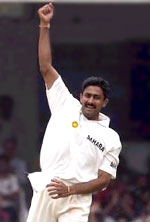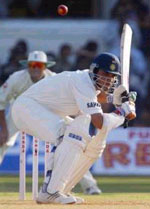
Of trial and errors
Prem Panicker
Hey, thanks a lot you guys -- following my last column, dozens of readers
from New York wrote in telling me that I was mistaken in assuming it was
difficult to follow cricket, live, from here.
And they're right -- it's easy as 1 2 3. One suggestion made was to opt
for the TV Asia cable service -- thanks for the suggestion, but I gave
that the go by because it is deferred live, with telecast starting only
at 4 pm (now why is that, I wonder?)
The other option the readers suggested turns out to be the simplest, and
best -- to wit, Wisden's streaming video. Back home in India, we
generally tend to resist the temptation to go in for broadband, thanks
to sluggish line speeds that defeat the purpose. Here, having watched
the first two sessions of the second Test live, I'm impressed. Ideally,
you want to see things large as life and twice as natural, but if you
discount that, this feed is as good as it gets.
On an unrelated note -- and I won't bring this up again -- the interest,
and support, for the game in this country continues to amaze (and, at times, amuse). Like, for instance, the other day I get a call from Prashanth Narella, wanting to know if I was planning a trip California
way. On being told no, he figures out a way of getting himself and a bunch of his friends into a room with a phone that has the conference feature, and we end up spending a good 45 minutes arguing cricket.
Amazing (the interest), amusing (talk of creative problem-solving), and
loads of fun.
To cut to the chase -- day one of the second Test provided food for
thought, even before the first ball was bowled.
Firstly, take the dropping of Anil Kumble. Forget the emotionalism -- Anil has won us more games, over the last decade or so, than any other
bowler or batsman. He is senior. He is captain designate, if and when
there is a change of guard.
 And yet and yet. His lifetime record outside of India is 108 wickets in
33 Tests at 40.50 (thanks, Anand Nair, for the research). That over his
last 10 away Tests (I was looking at the period 1998-2002), his figures
are 32 wickets at an average of 45.09 and a strike rate of a wicket
every 99.91 deliveries. (Incidentally, away from home Tendulkar takes
wickets at 41.08 and Ganguly at 40.33 average and 69.11 strike rate).
And yet and yet. His lifetime record outside of India is 108 wickets in
33 Tests at 40.50 (thanks, Anand Nair, for the research). That over his
last 10 away Tests (I was looking at the period 1998-2002), his figures
are 32 wickets at an average of 45.09 and a strike rate of a wicket
every 99.91 deliveries. (Incidentally, away from home Tendulkar takes
wickets at 41.08 and Ganguly at 40.33 average and 69.11 strike rate).
When you are playing in India -- or in fact anywhere in the world where
the pitch could break up, or provide inordinate (better still, uneven)
bounce, Kumble's is perhaps the first name you want to pencil in. But
when we are playing on seaming tracks? I am not so sure -- the above
figures certainly don't suggest that.
So, the dropping of Kumble for this Test is not as debatable as it
appears. In a sense, it is even very welcome -- assuming, that is, that
the team is finally beginning to realize that 'horses for courses' is in
fact a very sound policy.
I was once chatting with the late Ramakant Desai -- when he was chairman
of selectors -- about how teams are picked. And 'Tiny' Desai in all
seriousness said, 'See, when we sit down, we can pencil in 9 or 10 names
straightaway. It is the other four or five that we ponder over.'
This is one part of our problem -- we tend to approach cricket selection
as if it were the bureaucracy, picking names not on the basis of
conditions and opposition involved, but on the basis of 'seniority'.
The decision to rest Kumble for the Test now underway is perhaps the
first instance of its kind in recent memory, where a fully fit senior
player is being benched on the basis of suitability, or lack thereof,
for the game in question.
Or is it? Without going into how I know (I don't want to get a certain
very senior board official in trouble), I'll put all I have behind this
statement -- ever since the selectors indicated, late last year, that
Kumble is the man in waiting for the captaincy, the incumbent has in
various ways been attempting to get the leg-spinner axed.
'We should not take him on a long, tough tour of the West Indies; he has
just come out of a prolonged injury break, what if he aggravates that
injury, we need him for the World Cup which is more important' is,
typically, the argument that has been used.
Which is why I hope that the decision was taken by the right people for
the right reasons, and that we are not seeing backroom politics in
action again.
Once the team starts thinking of match situations and opposition and
picking teams and strategies accordingly, it would have taken a huge
step towards shedding an unwanted legacy of its past. It will put a
premium on performance rather than hype or seniority; it will mean that
anyone - any one -- who makes the final cut does so on merit and fitness
for the particular game, and not on the basis of past achievement. And
if all this becomes a trend, then it needs must reflect in results.
In passing, two thoughts arising from the action in the second Test thus
far (as I write this, India is 240/4 at the end of 65 overs). Sachin
Tendulkar is batting on his 29th Test century -- and very lucky to get
there, what's more. That caught behind appeal was not on, but I thought
he was a plumb-in-front candidate for the umpire's finger early on, but
the finger stayed down and Tendulkar stayed in. The only reason for the
umpire's decision in favor of the batsman, that I could see, was that
the ball was bowled from wide of the crease, and that kind of angle
tends to make the more cautious umpires a touch leery.
What was surprising about the early part of his innings was his
indecisive footwork -- it is very rare to see Sachin unsure of whether to
go on the front foot or back. Makes you wonder if it has to do with the
fact that of late, the batsman has been trying to re-engineer his
batting style or whether a pitch that before play began seemed to be a
true seamer's track has been showing signs of staying a touch low at
times. Which in turn makes you wonder whether Carl Hooper will have
cause to regret his decision to insert the opposition after winning the
toss.
Which brings up the second thought - what was Hooper thinking about
anyways? It was not like there was anything alarming in the shape of the
wicket (as far as I could see on the Wisden feed, that is -- which is
clear, but in terms of size is not quite the same as being able to see a
deck on TV, or in person) to justify insertion, and India seems to be
rubbing the point home by making runs without losing too many wickets.
Insertion puts the onus on the bowlers -- so what were they thinking of
through the day? The first hour-and-a-half saw no bouncers -- which in
itself raises eyebrows, since you would have thought they would want to
test both Das and Bangar on the short stuff.
 And then Sourav Ganguly, notoriously suspect against the short lifting
delivery, comes in to bat -- and doesn't have to face a single short
lifter. Weird, that -- I thought it was only the Indian think tank that
had a penchant for missing the obvious.
And then Sourav Ganguly, notoriously suspect against the short lifting
delivery, comes in to bat -- and doesn't have to face a single short
lifter. Weird, that -- I thought it was only the Indian think tank that
had a penchant for missing the obvious.
And finally, this -- on the one hand we talk of the need for regular
openers. And on the other, we keep experimenting with bits and pieces
players -- like, never mind if Dasgupta can't keep, he can open; never
mind if Bangar is not a specialist in the real sense of the word (sure,
he opens for his state - but by that yardstick, Devang Gandhi, Sujit
Somasundar, Vikram Rathore and a few dozen others do, but you wouldn't
want them to open for India would you?).
Ask yourself why, and the answer is -- lack of confidence. The Indians
lack confidence in their batting lineup, therefore they are constantly
looking for ways to bolster it. They lack confidence in their bowlers'
ability to win games, and so are constantly looking for ways to add
extra strings to their bowling bow.
And that brings us right back to where we started this -- would any of
this happen if players were chosen only on merit?
That question, in turn, brings up a certain Sourav Ganguly. I wouldn't
want to see India go into a one-day game without him -- but by the same
token, I wouldn't want to see India go into a Test on foreign soil with
him either.
Do the facts really need mentioning? Ganguly, lifetime: 27 Tests away,
40.60 average, 7 fifties, four hundreds. Ganguly since January 1999, 14
Tests away, 35.35 average, 5 fifties and 1 hundred. Ganguly since
January 2000, 10 Tests, 25.67 average, 2 fifties, no century.
Does this paint a steadily deteriorating picture?
Does this picture justify his continued place in the side?
Would Indian cricket be better served by having him focus on his one-day
cricket and spend the time away from Tests concentrating on ironing out
the chinks in his batting armory that have contributed to this decline?
Would Indian cricket benefit, in the interim, by using the slot thus
freed to give promising youngsters of the order of Virendra Sehwag,
Dinesh Mongia and Mohammad Kaif a chance to show the stuff they are made
of?
And finally, if you dropped an obviously out of sync batsman and
replaced him with one who merits his place, and thus really strengthened
the batting, would you need the sort of stop gap measures that, in
recent times, have gone by the names of Dasgupta and Bangar?
Questions, questions....
More Columns
Mail Prem Panicker